

Overview
| Organism | Homo sapiens, human |
|---|---|
| Tissue |
bone
|
| Cell Type | osteoblast; SV40 large T antigen transfected |
| Product Format | frozen |
| Culture Properties | adherent |
| Biosafety Level |
2 [Cells contain SV40 viral sequences]
Biosafety classification is based on U.S. Public Health Service Guidelines, it is the responsibility of the customer to ensure that their facilities comply with biosafety regulations for their own country. |
| Age | fetus |
| Applications | The cells provide a homogenous, rapidly proliferating model system for studying normal human osteoblast differentiation, osteoblast physiology, and hormonal, growth factor, and other cytokine effects on osteoblast function and differentiation. |
| Disclosure | This material is cited in a US or other Patent and may not be used to infringe the claims. Depending on the wishes of the Depositor, ATCC may be required to inform the Patent Depositor of the party to which the material was furnished. This material may not have been produced or characterized by ATCC. |
Properties
| Karyotype | diploid, 43%; tetraploid, 57% |
|---|---|
| Derivation |
This line was established by transfection of limb tissue obtained from a spontaneous miscarriage with the temperature sensitive expression vector pUCSVtsA58 and the neomycin resistance expression vector pSV2-neo. Clones were selected in the presence of 0.6 mg/mL G418.
|
| Antigen Expression |
SV40 T antigen
|
| Genes Expressed |
alkaline phosphatase
|
| Cellular Products |
alkaline phosphatase
|
| Comments |
Cells grown at a permissive temperature of 33.5��C exhibit rapid cell division (Doubling time of 36 hrs), whereas little cell division occurs at a restrictive temperature of 39.5��C (Doubling time of 96 hrs).
The cells have the ability to differentiate into mature osteoblasts expressing the normal osteoblast phenotype. At the restrictive temperatures, cell division is slowed, differentiation increases, and a more mature osteoblast phenotype is produced.
|
Background
| Complete Growth Medium |
The base medium for this cell line is a 1:1 mixture of Ham''''s F12 Medium Dulbecco''''s Modified Eagle''''s Medium,with 2.5 mM L-glutamine (without phenol red). To make the complete growth medium, add the following components to the base medium: 0.3 mg/ml G418; fetal bovine serum to a final concentration of 10%. |
|---|---|
| Subculturing |
Volumes are given for a 75 cm2 flask. Increase or decrease the amount of dissociation medium needed proportionally for culture vessels of other sizes.
Subcultivation Ratio: A subcultivation ratio of 1:4 is recommended
Medium Renewal: Every 2 to 3 days
|
| Cryopreservation |
culture medium, 72%; additional fetal bovine serum, 20%; DMSO, 8%
|
| Culture Conditions |
Temperature: 34��C
|


